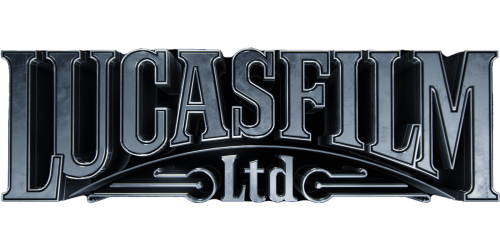
| |
| Distance from core | 43,000 light years[1] |
|---|---|
| Region | Outer Rim Territories |
| Oversector | Oversector Outer |
| Sector | Arkanis Sector |
| System | Tatoo |
| Number of suns | 2 |
| Number of moons | 3 |
| Population | 200,000[1] |
| Species | Assorted (primarily Humans, Jawas, and Tusken Raiders) |
| Points of Interest | Anchorhead, Mos Eisley, Mos Espa |
| Surface water | 1% |
| Affiliation | Galactic Republic, Rebel Alliance, New Republic and Resistance |
Template:Portal Tatooine /ˌtætuːˈiːn/ is a fictional planet and setting for many key scenes in the Star Wars saga, appearing in every Star Wars film except The Empire Strikes Back, although it is mentioned at the end of the movie. Since it is the home planet of Anakin Skywalker and Luke Skywalker, it is one of the most iconic planets in the Star Wars universe.
Description[]
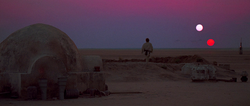
Tatooine has two stars, as it is in a binary star system. This shot from A New Hope remains one of the most famous scenes of the entire saga.[2]
Tatooine is a desert planet in a binary star system. It once had large oceans full of marine based life and a world-spanning jungle, but this biosphere was destroyed when the myopic Rakata razed the planet, drying up its riverbeds and boiling away its oceans.[citation needed]
Tatooine's G-type and K-type twin stars (Tatoo I and Tatoo II) heat its surface, making water and shade hard to come by. The planet's indigenous lifeforms—such as the Womp rat, bantha, Sarlacc, and Krayt Dragon—are well-adapted to its arid climate, but human settlers often become moisture farmers and live in subterranean dwellings in order to survive. The planet's lack of resources, brutal heat, and decentralized population have made governing the planet nearly impossible.
The planet fell into the clutches of the Hutts, a clan of gangsters and crime lordsTemplate:When. Since Tatooine was beyond the reach of the Galactic Republic, the Hutts presided over the lawless planet with little outside interference. When the Galactic Empire subsumed the Old Republic, the new regime established only a token presence on Tatooine, which left Jabba the Hutt’s reign unchallenged. Jabba remained the assumed ruler of Tatooine until his death in the Battle of Carkoon.
Sentient inhabitants[]
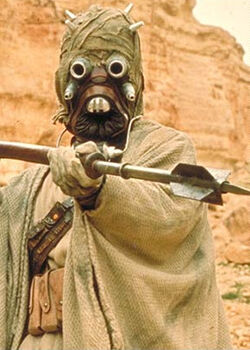
A Tusken Raider, a native inhabitant of Tatooine
- Humans — Settlers
- Hutts — Slug-like crime lords
- Jawas — Short, humanoid scavengers and traders
- Tusken Raiders (or Sand People) — Fierce, nomadic humanoids and the native people of Tatooine
Flora[]
- Trees — Rare, knotted vegetation. Most were planted by an exiled Ithorian.[citation needed]
Fauna[]
- Banthas
- Dewbacks
- Tatooine Howlers
- Eopies
- Krayt dragons
- Rontos
- Sarlacc — semi-sentient, plant-like, omnivorous creature
- Scurriers
- Womp rats
- Wraids
- Worrts
- Galoomps
- Anoobas
- Jackrabs
- Profoggs
- Urusai
- Woodoo
- Sketto
- Gorg
- Rancor (Rare, not native)
Locations[]
Anchorhead[]
- Main article: List of Star Wars cities#Anchorhead
Anchorhead is a settlement located a few miles east of the Lars family home, south of the bustling spaceport of Mos Eisley, and primarily consists of moisture farmers.
Bestine[]
Bestine, the "capital" of Tatooine, is situated far west of Mos Eisley near the south-western Dune Sea. It was also one of the earliest settlements on the planet but never thrived economically, sharing the same problems as many other settlements on the dry world. The Galactic Empire eventually established its base of operations here and placed its regional governor in the city's Main Hall. It is featured prominently in Star Wars: Galaxies.
Dune Sea[]
The Dune Sea is a huge sandy desert, near the cities of Anchorhead, Mos Eisley and Tosche Station. It is inhabited solely by Tusken Raiders, Jawas, wraids, dewbacks and the occasional Krayt dragon. Moisture farmers often have many moisture vaporators located in the Dune Sea to collect the scarce water vapor from the air.
Great Pit of Carkoon[]
- Main article: Sarlacc
The Great Pit of Carkoon is located within the Dune Sea. It is a large depression in the desert sand created by the Sarlacc, a large omnivorous[citation needed] creature that uses the pit to capture prey. The Great Pit of Carkoon is the site of a skirmish that takes place between Luke Skywalker and the forces of Jabba the Hutt. The Hutt crime lord and most of his minions were killed during the battle.
Jabba's Palace[]
Jabba's Palace, is located in the desert known as the Dune Sea and was home to the gangster high boss Jabba the Hutt. It is introduced as the main setting of the beginning of Return of the Jedi. Jabba's palace is also the main setting in Tales From Jabba's Palace edited by Kevin J. Anderson, as well as a playable area in the video games Super Star Wars: Return of the Jedi and Star Wars: Battlefront II. The palace was originally a monastery built by the mysterious B'omarr monks, who still inhabit parts of the palace. Jabba's Palace is very much infamous for bounty hunters,mercenaries,rogues,thiefs, and many other known assassins to claim rewards task's.
Jundland Wastes[]
The Jundland Wastes occupy most of Tatooine's temperate area, a rocky region known for its numerous cliffs and a multitude of hidden dangers. Obi-Wan Kenobi lived in a small dwelling on the edge of the Jundland Wastes after he took the infant Luke Skywalker to live on a moisture farm with relatives to hide the boy from Darth Vader. This area is also a level in the video games LEGO Star Wars II: The Original Trilogy and LEGO Star Wars: The Complete Saga.
Moisture farms[]
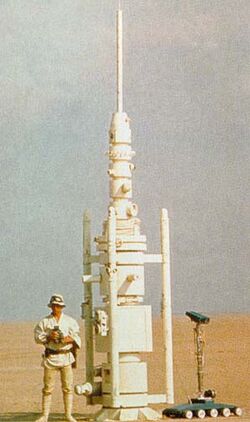
Luke Skywalker next to a moisture vaporator on Tatooine
Moisture farms are small agricultural settlements found in the deserts of Tatooine that utilize a large number of moisture collecting devices spread over a wide area to harvest water from the relatively dry air of the planet. Luke Skywalker spent his early years living with his Uncle Owen and Aunt Beru on a moisture farm. Moisture farmers harvest water vapour from the atmosphere, and use it to grow crops in underground hydroponic labs.
Mos Eisley[]
- Main article: Mos Eisley
Mos Eisley is a spaceport town. In Star Wars Episode IV: A New Hope, Obi-Wan Kenobi described Mos Eisley as a "wretched hive of scum and villainy." It is also the home of the Mos Eisley Cantina and Figrin D'an and the Modal Nodes.
Mos Eisley Cantina[]
- Main article: Mos Eisley Cantina
The Mos Eisley Cantina, officially named Chalmun's Cantina, is a bar located in Mos Eisley. It is the haunt of freighter pilots and other dangerous characters of varying races. In Star Wars Holiday Special, the Cantina is run by Ackmena (Bea Arthur).
It is featured in LEGO Star Wars II: The Original Trilogy and LEGO Star Wars: The Complete Saga.
Mos Espa[]
Mos Espa is a city known for its distinct "chicken" domed buildings. It is home to a podracing track and was the home of Anakin and Shmi Skywalker in Star Wars Episode I: The Phantom Menace. There was a large slave quarter within the rugged city.
Tosche Station (Toshi Station)[]
The Tosche Station, or Tosche Power Station, is a general store found in the city of Anchorhead. It sells a variety of goods. Tosche Station serves as the central location in the Anchorhead Story of Star Wars, a series of scenes that were deleted from Episode IV. It is described as a frequent hangout for Anchorhead's youth due to the fact that its owner, Merle Tosche, is seldom around. In his absence, "Fixer" runs the business, accompanied by his girlfriend Camie, and assisted by a repair droid.
Tatooine's namesake[]
The planet is not actually named in Star Wars Episode IV: A New Hope; according to Lucas he intended to name it Utapau but finally he named it retrospectively after a town near the movie's desert outdoor set,[3][4][5][6] Tataouine (French spelling) or Tataween spelling in southern Tunisia. Utapau however was given to a different planet, in Star Wars Episode III: Revenge of the Sith.[7] Location filming was not done in the Tunisian town of Tataouine itself, but instead at Tunisian locations such as the Hotel Sidi Driss in Matmâta, Djerba, and Tozeur.
The name "Tataouine" comes from the Berber word "Tiṭṭawin" literally meaning "the eyes" and figuratively "the water springs". The city of Tetouan in northern Morocco has the same root.
Appearances[]
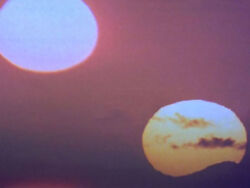
Tatooine's twin suns, Tatoo I and Tatoo II
- Lego Star Wars: The Complete Saga
- Lego Star Wars: The Video Game
- Lego Star Wars II: The Original Trilogy
- Lego Star Wars III: The Clone Wars
- Star Wars Battlefront
- Star Wars Battlefront II
- Star Wars Battlefront - Elite Squadron
- Star Wars Empire At War
- Star Wars Bounty Hunter
- Star Wars: The Clone Wars
- Star Wars: Droid Works
- Star Wars Episode I: The Phantom Menace
- Star Wars Episode I: The Phantom Menace (novel)
- Star Wars Episode II: Attack of the Clones
- Star Wars Episode III: Revenge of the Sith
- Star Wars Episode IV: A New Hope
- Star Wars Episode V: The Empire Strikes Back (mentioned only)
- Star Wars Episode VI: Return of the Jedi
- Star Wars Episode III: Revenge of the Sith (video game)
- Star Wars Galactic Battlegrounds
- Star Wars: Galactic Battlegrounds: Clone Campaigns
- Star Wars Galaxies: An Empire Divided
- Star Wars Holiday Special
- Star Wars: Knights Of The Old Republic (video game)
- Star Wars: Knights of the Old Republic II The Sith Lords (video game; mention only)
- Star Wars Jedi Knight: Jedi Academy (video game)
- Star Wars: Rogue Squadron (video game; both level 1 and a bonus level are situated on Tatooine)
- Star Tours: The Adventures Continue
- Star Wars: The Old Republic (video game)
- Angry Birds Star Wars
- Angry Birds Star Wars II
- Star Wars: Episode IX The Rise of Skywalker
References[]
Cited references[]
- ↑ 1.0 1.1 (2005) Star Wars: Complete Locations. Dorling Kindersley. ISBN 0-7566-1419-8.
- ↑ http://www.greatestfilms.org/scenes41.html
- ↑ Star Wars: The Abandoned Movie Set - blog.stuttgarter-zeitung.de
- ↑ 33°59’39 N 7°50’34 E - Google Maps
- ↑ GUERRILLA INNOVATION: (Star Wars Abandoned Movie Set)
- ↑ NO MORE STARS - Rä di Martino
- ↑ The Making of Star Wars: The Definitive Story Behind the Original Film, April 24, 2007, Del Rey. ISBN 0-345-47761-8
General references[]
- Star Wars: The Annotated Screenplays, softcover, 1997. George Lucas, Leigh Brackett, Lawrence Kasdan, Laurent Bouzereau, ISBN 0-345-40981-7
- Star Wars: Tales from the Mos Eisley Cantina, 1st paperback printing, 1995. Kevin J. Anderson (editor of anthology). ISBN 0-553-56468-4
- Star Wars: Tales from Jabba's Palace, 1st edition, 1995. Kevin J. Anderson (editor), ISBN 0-553-56815-9
- Star Wars, Darksaber, 1st paperback printing, 1995. Kevin J. Anderson, ISBN 0-553-57611-9
- The Essential guide to Planets and Moons (Star Wars), 1st edition, by Daniel Wallace, Scott Kolins. 1998. ISBN 0-345-42068-3
External links[]
- Tatooine in the Official StarWars.com Encyclopedia
- Tatooine on Wookieepedia: a Star Wars wiki
| This page uses content from the English Wikipedia. The original article was at Tatooine. The list of authors can be seen in the page history. As with Lucasfilm Wiki, the text of Wikipedia is available under the GNU Free Documentation License. |
